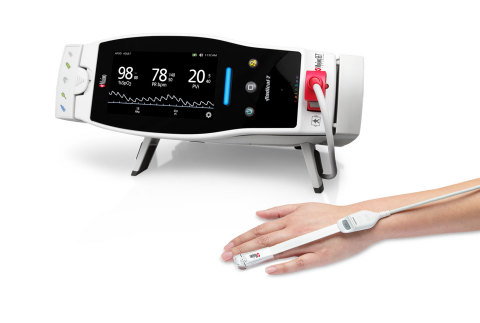Study Investigates the Ability of Masimo PVi® to Predict Preload Responsiveness in Patients On Nasal High-Flow Therapy
Masimo (NASDAQ: MASI) announced a study published in the Journal of Applied Physiology evaluating the Pleth Variability Index (PVi®) for predicting preload responsiveness in patients receiving nasal high-flow therapy. Conducted by Dr. Marina García-de-Acilu and colleagues, the research involved 20 ICU patients with acute respiratory failure. PVi demonstrated high sensitivity (91.7%) and specificity (87.8%) in identifying preload responders. While the findings suggest potential clinical utility, further validation is needed. The study indicates that PVi may not be universally applicable across all patients treated with high-flow therapy.
- PVi demonstrated high sensitivity (91.7%) and specificity (87.8%) for identifying preload responders.
- The study provides evidence supporting PVi's utility in clinical decision-making for critically ill patients.
- PVi may not accurately identify preload responders in all patients, indicating variability in effectiveness.
- The findings suggest that fluid management should not solely rely on PVi; a complete patient assessment is essential.
Insights
Analyzing...
Masimo (NASDAQ: MASI) announced today the findings of a study published in the Journal of Applied Physiology in which Dr. Marina García-de-Acilu and colleagues at the Vall d’Hebron University Hospital in Barcelona evaluated the utility of Masimo PVi® as a noninvasive method of predicting preload responsiveness in patients treated with nasal high-flow (NHF) therapy. They found that PVi may identify preload responders and noted that PVi may therefore be used in the “day-to-day clinical decision-making process in critically ill patients treated with NHF, helping to provide adequate resuscitation volume.”1 More than 100 independent studies have demonstrated the utility of PVi as an indicator of fluid responsiveness.2 This is the first time PVi has been evaluated in patients treated with NHF therapy.

Masimo Radical-7® with PVi® (Photo: Business Wire)
Noting the potential convenience of a noninvasive method of predicting fluid responsiveness in NHF patients, the researchers sought to evaluate whether PVi, which is noninvasive and easy to use, could play such a role. To do so, they compared PVi to reference measurements—stroke volume (SV) and cardiac output (CO)—in 20 adult ICU patients with acute respiratory failure (ARF) supported by NHF (flow ≥ 30 L/min). SV and CO were measured using transthoracic echocardiography (TTE) using a portable echocardiogram. PVi was measured using a Masimo Radical-7® Pulse CO-Oximeter® with a pulse oximetry sensor attached to the finger. Within the first 24 hours of NHF support, the patients’ SV/CO and PVi were assessed. Passive leg raising (PLR) was performed and SV/CO and PVi were then reassessed. Preload responsiveness was defined as a ≥
The researchers found that preload responders showed higher baseline PVi values and ΔPVi after PLR. PVi and ΔPVi after PLR showed “excellent diagnostic accuracy for predicting preload responsiveness.” At a baseline cut-off value of
The researchers concluded, “This physiological study suggests that PVi might predict preload responsiveness in hypoxemic ARF patients treated with NHF. Further research should focus on validating these results and analyze whether PVi-guided fluid administration can improve outcomes in NHF patients.”
The researchers also noted that PVi may not be sufficient to identify preload responders in all patients using NHF, hypothesizing that the intrathoracic pressures delivered by NHF are lower than those generated during invasive mechanical ventilation and that therefore a certain degree of hypoperfusion might potentially be required to effect changes in baseline PVi.
The accuracy of PVi in predicting fluid responsiveness is variable and influenced by numerous patient, procedure, and device-related factors. PVi measures the variation in the plethysmography amplitude but does not provide measurements of stroke volume or cardiac output. Fluid management decisions should be based on a complete assessment of the patient’s condition and should not be based solely on PVi.
In the U.S., PVi is cleared as a noninvasive, dynamic indicator of fluid responsiveness in select populations of mechanically ventilated adult patients.
@Masimo | #Masimo
About Masimo
Masimo (NASDAQ: MASI) is a global medical technology company that develops and produces a wide array of industry-leading monitoring technologies, including innovative measurements, sensors, patient monitors, and automation and connectivity solutions. Our mission is to improve patient outcomes, reduce the cost of care, and take noninvasive monitoring to new sites and applications. Masimo SET® Measure-through Motion and Low Perfusion™ pulse oximetry, introduced in 1995, has been shown in over 100 independent and objective studies to outperform other pulse oximetry technologies.3 Masimo SET® has also been shown to help clinicians reduce severe retinopathy of prematurity in neonates,4 improve CCHD screening in newborns,5 and, when used for continuous monitoring with Masimo Patient SafetyNet™ in post-surgical wards, reduce rapid response team activations, ICU transfers, and costs.6-9 Masimo SET® is estimated to be used on more than 200 million patients in leading hospitals and other healthcare settings around the world,10 and is the primary pulse oximetry at 9 of the top 10 hospitals according to the 2020-21 U.S. News and World Report Best Hospitals Honor Roll.11 Masimo continues to refine SET® and in 2018, announced that SpO2 accuracy on RD SET® sensors during conditions of motion has been significantly improved, providing clinicians with even greater confidence that the SpO2 values they rely on accurately reflect a patient’s physiological status. In 2005, Masimo introduced rainbow® Pulse CO-Oximetry technology, allowing noninvasive and continuous monitoring of blood constituents that previously could only be measured invasively, including total hemoglobin (SpHb®), oxygen content (SpOC™), carboxyhemoglobin (SpCO®), methemoglobin (SpMet®), Pleth Variability Index (PVi®), RPVi™ (rainbow® PVi), and Oxygen Reserve Index (ORi™). In 2013, Masimo introduced the Root® Patient Monitoring and Connectivity Platform, built from the ground up to be as flexible and expandable as possible to facilitate the addition of other Masimo and third-party monitoring technologies; key Masimo additions include Next Generation SedLine® Brain Function Monitoring, O3® Regional Oximetry, and ISA™ Capnography with NomoLine® sampling lines. Masimo’s family of continuous and spot-check monitoring Pulse CO-Oximeters® includes devices designed for use in a variety of clinical and non-clinical scenarios, including tetherless, wearable technology, such as Radius-7® and Radius PPG™, portable devices like Rad-67®, fingertip pulse oximeters like MightySat® Rx, and devices available for use both in the hospital and at home, such as Rad-97®. Masimo hospital automation and connectivity solutions are centered around the Masimo Hospital Automation™ platform, and include Iris® Gateway, iSirona™, Patient SafetyNet, Replica™, Halo ION™, UniView®, UniView :60™, and Masimo SafetyNet™. Additional information about Masimo and its products may be found at www.masimo.com. Published clinical studies on Masimo products can be found at www.masimo.com/evidence/featured-studies/feature/.
ORi and RPVi have not received FDA 510(k) clearance and are not available for sale in the United States. The use of the trademark Patient SafetyNet is under license from University HealthSystem Consortium.
References
- García-de-Acilu M, Pacheco A, Santafé M, Francisco-Javier R, Ruiz-Rodríguez J, Ferrer R, Roca O. Pleth variability index may predict preload responsiveness in patients treated with nasal high flow: a physiological study. J Appl Physiol. 2021 Apr 15. DOI: 10.1152/japplphysiol.00614.2020.
- Published clinical studies on PVi, with varying results and outcomes, can be found on our website at http://www.masimo.com/evidence/pulse-oximetry/pvi. Studies include independent and objective studies which are comprised of abstracts presented at scientific meetings and peer-reviewed journal articles.
- Published clinical studies on pulse oximetry and the benefits of Masimo SET® can be found on our website at http://www.masimo.com. Comparative studies include independent and objective studies which are comprised of abstracts presented at scientific meetings and peer-reviewed journal articles.
- Castillo A et al. Prevention of Retinopathy of Prematurity in Preterm Infants through Changes in Clinical Practice and SpO2 Technology. Acta Paediatr. 2011 Feb;100(2):188-92.
- de-Wahl Granelli A et al. Impact of pulse oximetry screening on the detection of duct dependent congenital heart disease: a Swedish prospective screening study in 39,821 newborns. BMJ. 2009;Jan 8;338.
- Taenzer A et al. Impact of pulse oximetry surveillance on rescue events and intensive care unit transfers: a before-and-after concurrence study. Anesthesiology. 2010:112(2):282-287.
- Taenzer A et al. Postoperative Monitoring – The Dartmouth Experience. Anesthesia Patient Safety Foundation Newsletter. Spring-Summer 2012.
- McGrath S et al. Surveillance Monitoring Management for General Care Units: Strategy, Design, and Implementation. The Joint Commission Journal on Quality and Patient Safety. 2016 Jul;42(7):293-302.
- McGrath S et al. Inpatient Respiratory Arrest Associated With Sedative and Analgesic Medications: Impact of Continuous Monitoring on Patient Mortality and Severe Morbidity. J Patient Saf. 2020 14 Mar. DOI: 10.1097/PTS.0000000000000696.
- Estimate: Masimo data on file.
- http://health.usnews.com/health-care/best-hospitals/articles/best-hospitals-honor-roll-and-overview.
Forward-Looking Statements
This press release includes forward-looking statements as defined in Section 27A of the Securities Act of 1933 and Section 21E of the Securities Exchange Act of 1934, in connection with the Private Securities Litigation Reform Act of 1995. These forward-looking statements include, among others, statements regarding the potential effectiveness of PVi®. These forward-looking statements are based on current expectations about future events affecting us and are subject to risks and uncertainties, all of which are difficult to predict and many of which are beyond our control and could cause our actual results to differ materially and adversely from those expressed in our forward-looking statements as a result of various risk factors, including, but not limited to: risks related to our assumptions regarding the repeatability of clinical results; risks related to our belief that Masimo's unique noninvasive measurement technologies, including PVi, contribute to positive clinical outcomes and patient safety; risks related to our belief that Masimo noninvasive medical breakthroughs provide cost-effective solutions and unique advantages; risks related to COVID-19; as well as other factors discussed in the "Risk Factors" section of our most recent reports filed with the Securities and Exchange Commission ("SEC"), which may be obtained for free at the SEC's website at www.sec.gov. Although we believe that the expectations reflected in our forward-looking statements are reasonable, we do not know whether our expectations will prove correct. All forward-looking statements included in this press release are expressly qualified in their entirety by the foregoing cautionary statements. You are cautioned not to place undue reliance on these forward-looking statements, which speak only as of today's date. We do not undertake any obligation to update, amend or clarify these statements or the "Risk Factors" contained in our most recent reports filed with the SEC, whether as a result of new information, future events or otherwise, except as may be required under the applicable securities laws.
View source version on businesswire.com: https://www.businesswire.com/news/home/20210502005039/en/







